Crop Circle Art
-
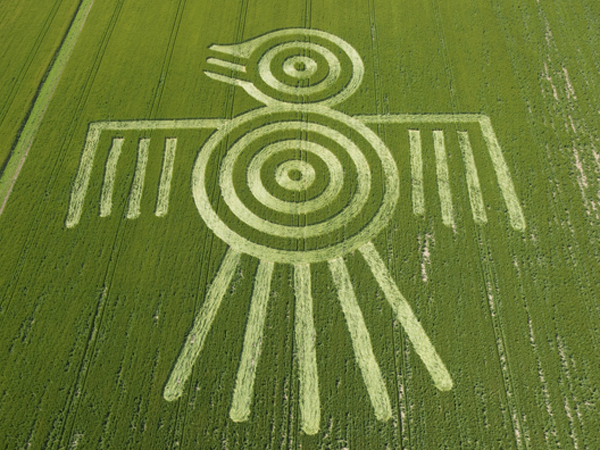 Photograph courtesy Steve Alexander, http://www.temporarytemples.co.uk/.
Photograph courtesy Steve Alexander, http://www.temporarytemples.co.uk/.Wheat Field at Barbury Castle, Wiltshire: June 14, 2009
Crop circles have persistently defied scientific explanation, inspiring any number of outlandish theories about ancient shamanism and extraterrestrial visitations. Now, an Oregon physicist has added his own theory to the mix: that these dazzlingly complex patterns stamped in the countryside are the work of imaginative geeks with gadgets. In an article in the August issue of Physics World, Richard Taylor, director of the Material Science Institute at the University of Oregon, argues that the designs, which have become increasingly common in fields of wheat, barley, maize, and grass since the 1970s, could be produced by artists using global positioning systems (to translate the coordinates of complex designs from computers, to vast fields) , lasers (to aid in drawing straight lines), and microwaves (to knock down the stalks).
Crop photographer and researcher Steve Alexander, who shared the photos in this gallery, says that Richard Taylor’s theory “seems as way out as aliens making circles.” But he doesn’t dismiss it entirely: “That’s what is so great about the circles. There are as many theories as there are circles.” The following gallery presents the most striking examples of the art from Alexander’s extensive collection. All were captured in England.
-
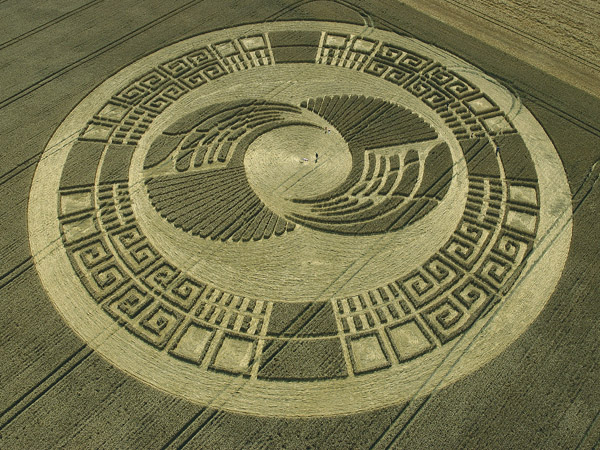 Photograph courtesy Steve Alexander, http://www.temporarytemples.co.uk/.
Photograph courtesy Steve Alexander, http://www.temporarytemples.co.uk/.Wheat Field on Silbury Hill, Wiltshire: Aug. 2, 2004
Taylor’s theory about microwaves and GPS devices has one obvious problem: These tools were not available to early crop circilists. Before artists could use this technology, Taylor theorizes, they were fashioning their shapes from “stompers,” wooden planks attached to ropes and bar stools that allowed them to flatten the crops. Today’s technology, he believes, has contributed to more intricate patterns, some displaying up to 2000 individual shapes—a mastery that was arguably not possible in previous decades.
-
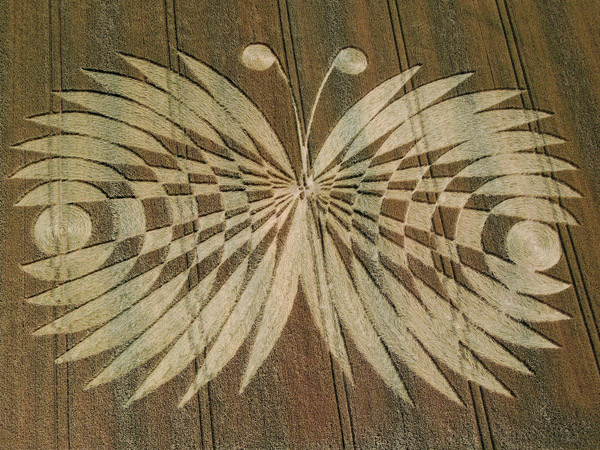 Photograph courtesy Steve Alexander, http://www.temporarytemples.co.uk/.
Photograph courtesy Steve Alexander, http://www.temporarytemples.co.uk/.Wheat Field in Hailey Wood, Oxfordshire: July 16, 2007
One of the most puzzling aspects of crop designs stems from the positioning of the stalks: They’re bent, but not broken, and created with stunning speed. According to Taylor, microwave signals, like those that heat your food, can produce this intricate phenomenon by zapping the stalks. The BLT Research Team, a group of crop-circle researchers, got the same results by putting crops in microwave ovens and exposing them to the rays for 30 seconds. Still, Taylor notes, biophysicists will need “to expand on these preliminary experiments” for the theory to be accepted in the wider scientific community.
-
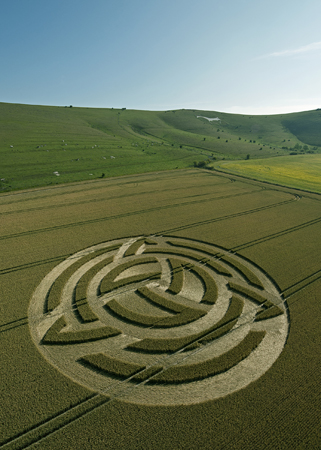 Photograph courtesy Steve Alexander, http://www.temporarytemples.co.uk/.
Photograph courtesy Steve Alexander, http://www.temporarytemples.co.uk/.Wheat Field on Milk Hill in Wiltshire: July 8, 2011
About one-half of the documented crop circles appear in England, but they’ve been reported in more than 50 countries. They materialize, Taylor says, “at the rate of one event worldwide every summer evening.”
-
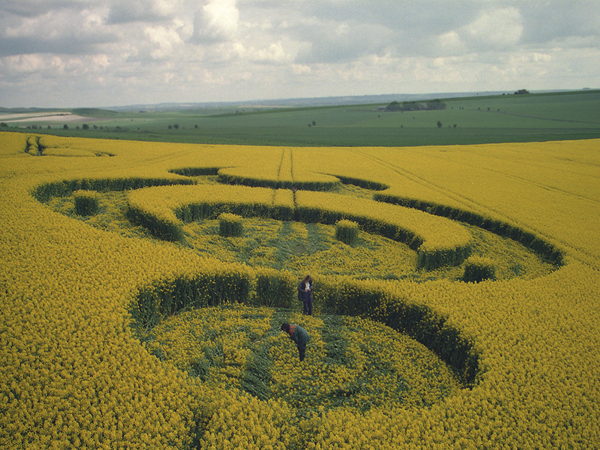 Photograph courtesy Steve Alexander, http://www.temporarytemples.co.uk/.
Photograph courtesy Steve Alexander, http://www.temporarytemples.co.uk/.Oilseed Rape Field in Furze Knoll, Devizes, Wiltshire: July 5, 1994
In 1991, just three years before this image was captured, Doug Bower and Dave Chorley took responsibility for constructing hundreds of crop circles since the late 1970s using “stompers”—a rather more crude method involving wooden planks attached to ropes and bar stools . Still, the two Englishmen didn’t claim to be the creators of all of the crop circles during that time period.
-
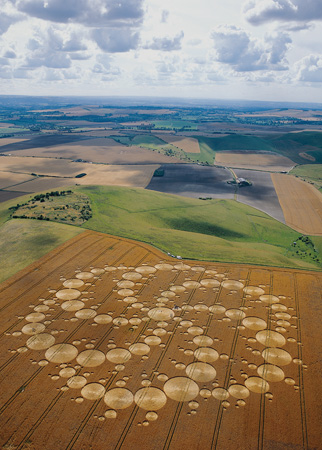 Photograph courtesy Steve Alexander, http://www.temporarytemples.co.uk/.
Photograph courtesy Steve Alexander, http://www.temporarytemples.co.uk/.Wheat Field on Milk Hill in Wiltshire: Aug. 12, 2001
One of the first alleged crop-circle sightings was documented on a 1678 woodcut pamphlet called The Mowing-Devil. It offers the tale of an oat farmer in Hertfordshire, England, who refuses to pay the (human) reaper’s inflated fees at the beginning of harvest season, muttering that he’d rather the devil collect his crop than fork over the cash. The next morning, his oats were “laid down in round circles.” He fled. More than 300 years later, this type of mythology persists around crop circles like this one: It’s one of the largest recorded crop circle designs, measuring more than 900 feet in diameter. The average circle spans about 200 to 300 feet.
-
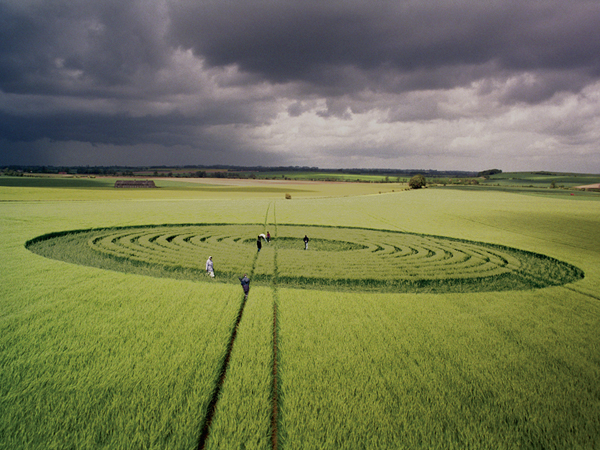 Photograph courtesy Steve Alexander, http://www.temporarytemples.co.uk/.
Photograph courtesy Steve Alexander, http://www.temporarytemples.co.uk/.Barley Field in Beckhampton, Wiltshire: May 29, 1995
The farmers whose crops are destroyed in the name of the occult are not amused. Tim Carson, who has reported 125 circles on his land since 1990, spoke to the U.K.’s Daily Mail about the designs: “I’m beginning to get a bit tired of it all,” says Carson. “Each circle costs me about £1,000 [about $1,600] in lost income … whatever you do, the circles affect the growing next year, as the thick mat of crops covers soil, compromising its quality.”
-
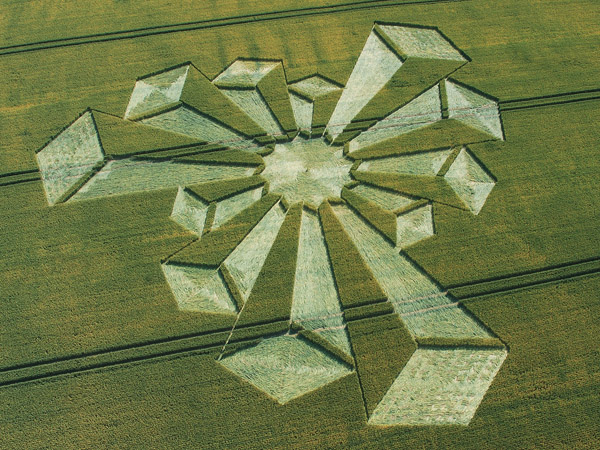 Photograph courtesy Steve Alexander, http://www.temporarytemples.co.uk/.
Photograph courtesy Steve Alexander, http://www.temporarytemples.co.uk/.Wheat Field in Waylands Smithy, Oxfordshire: Aug. 7, 2006
The circles have broader implications for consumers, too: After all, the crops in the circles—which, according to studies from 1999 and 2001 cited by Taylor, might be flattened by radiation—will still appear on dinner tables around the world. “If there is some unknown technology being used to generate these patterns, and it is radiation, it’s not a sort of abstract study,” Taylor says. “Whatever’s going on in those fields is affecting the food that [we’re] eating.” The comparative health risks of alien infiltration versus microwave radiation remain an unresolved question in science.